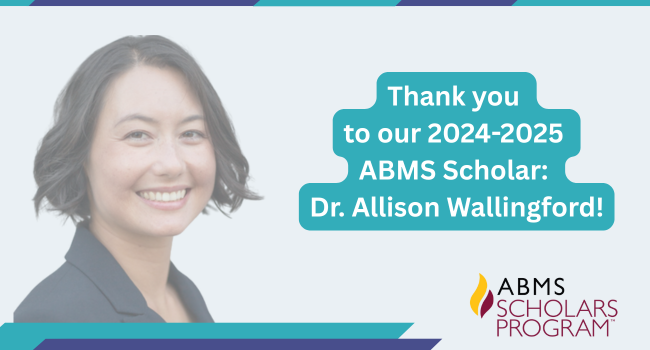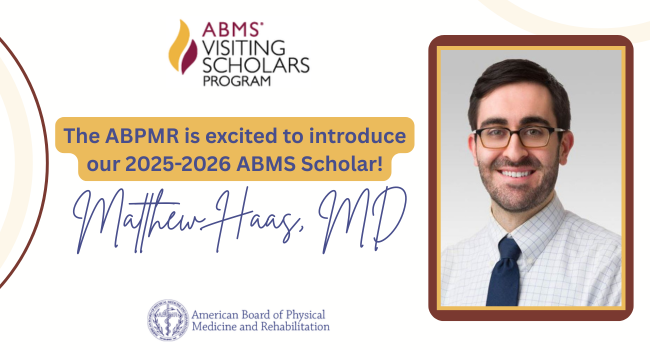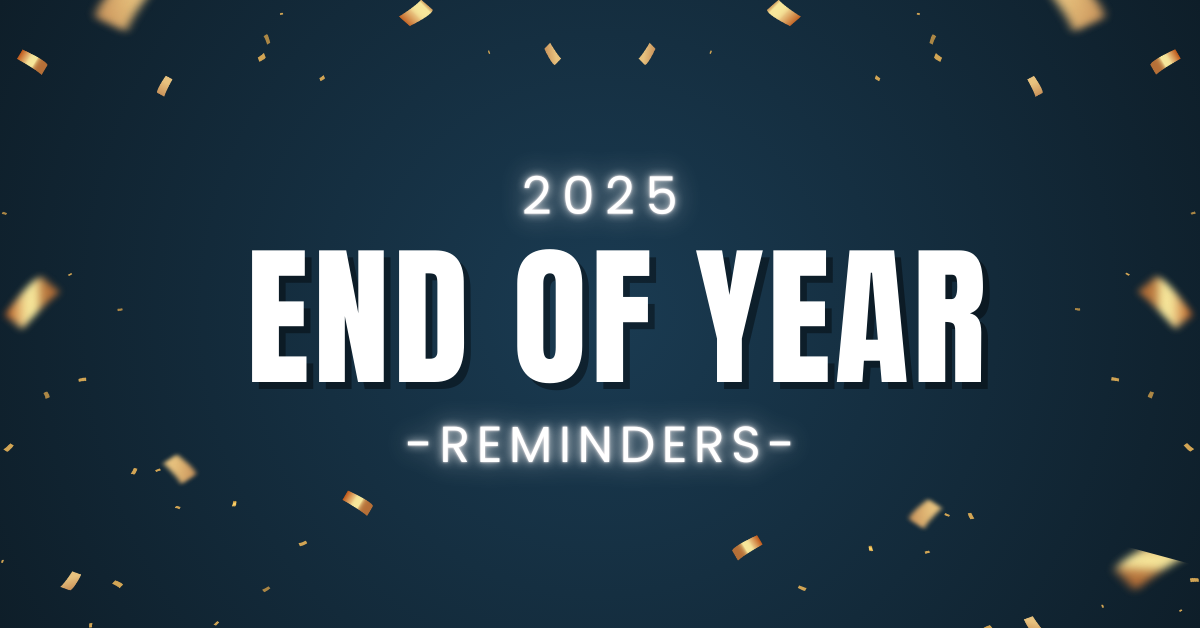Physician Features
Volunteer Spotlight: Suehun Ho, MD
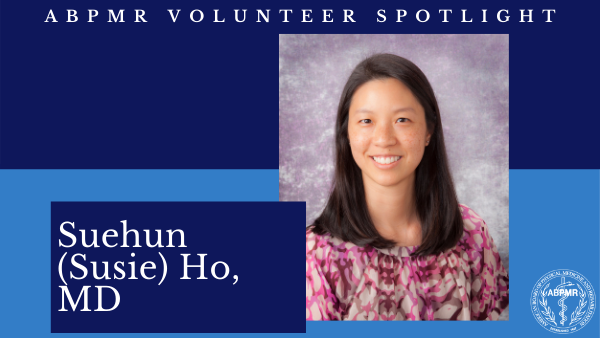
Our February Volunteer Spotlight is Suehun (Susie) Ho, MD! The ABPMR Volunteer Spotlight showcases ABPMR volunteers and their work that allows the ABPMR to fulfill our mission of serving the public by setting the standard for quality in PM&R. We are grateful for all the time and hard work each volunteer gives—thank you for every way you continue to serve!
Dr. Ho is currently Clinical Assistant Professor at the University of Pittsburgh Medical Center Department of Physical Medicine and Rehabilitation. Her medical practice focuses on non-operative spine care and musculoskeletal/sports. She attended medical school at Northeast Ohio Medical University in Rootstown, OH, and completed her PM&R residency and Pain Management Fellowship at the University of Michigan. She received her initial certification in PM&R in 2006, and has since received her subspecialty certification in Pain Medicine (2007) and Sports Medicine (2013).
During her time as an ABPMR volunteer the past several years, Dr. Ho has volunteered as an examiner for the Part II Examination, an item writer for the Part I Examination, and a senior reviewer for LA-PM&R (Longitudinal Assessment for PM&R). In 2020, she served as an examiner for two of the three Part II Examination administrations.
We talked with Dr. Ho about her career (and how her interest in PM&R started early in life), her busy volunteer schedule with the ABPMR, and the sense of camaraderie she feels as an examiner.
How did you get started in physical medicine and rehabilitation?
My dad is a physiatrist so I was exposed to PM&R at a young age. He worked for the Veterans Affairs Medical Center, so I was able to see some of the research he was doing. When I got into medical school, I was debating between PM&R and pediatrics. I even considered surgery because I really like working with my hands. Ultimately, I decided on PM&R because I felt it was the most rewarding. I tell medical students who are considering our field that in PM&R, you see patients at their lowest low and you help gradually build them up. You get them to the point where they are functional and as independent as possible, which is the part I find really rewarding.
Where did you end up going to medical school?
I did a six-year BS/MD [Bachelor of Science and Doctor of Medicine] program at Northeast Ohio Medical University. I then did my internship in Ohio, and my residency and fellowship at the University of Michigan.
Did you grow up in Ohio?
I grew up in the Midwest in Illinois and Ohio. When I finished my fellowship, I was at the University of Michigan for two years, then moved to Syracuse and was there for seven years. About five years ago, we moved to Pittsburgh to be closer to family. I’ve been at the University of Pittsburgh Medical Center since 2015 and live in one of the suburbs of Pittsburgh.
When did you become certified in PMR?
My primary certification was 2006. My subspecialty board certification in Pain Medicine was in 2007 and Sports Medicine was in 2013.
What does your day-to-day look like with the residency program?
I have a mix of outpatient clinic and interventional procedures, and I’m also involved in teaching the residents, pain fellows, and medical students.
When did you start volunteering with ABPMR?
I got called in 2012 to volunteer as an examiner— I was pregnant and due around the time of the Part II Examination, so I asked to defer a year. My first year volunteering was in 2013!
Did you start as an examiner?
I started as a Part II examiner, and I am also an item writer for Part I and a senior reviewer for LA-PM&R. Item writing is a lot different than what I imagined it to be, and I have a lot of respect for the process after going through it. When you take the test, sometimes you wonder why a question is on there. However, when you go through the writing process, you gain a better appreciation for why the questions are on there and why they are written the way they are. There is so much thought that goes behind each question and there is a lot of literature that backs up the answers. It is amazing to think about all the time that goes into writing one question!
What do you appreciate about being an examiner and an item writer, and how do you see yourself learning from both perspectives of writing questions and administering questions for the exams?
It was interesting to go through the examiner training. Understanding the process of the oral boards and the item writing, you appreciate how much thought goes into each step. You don’t get that sense as an examinee because you are so nervous! There are experts from each subspecialty at the oral boards and I certainly learn from them through this process.
What do you enjoy about being an examiner?
The camaraderie. I love meeting up with people I haven’t seen in a while and seeing past residents that I have worked with who are also examiners. Dr. Tony Chiodo was one of my mentors at the University of Michigan, and it was great to see him in person each year.
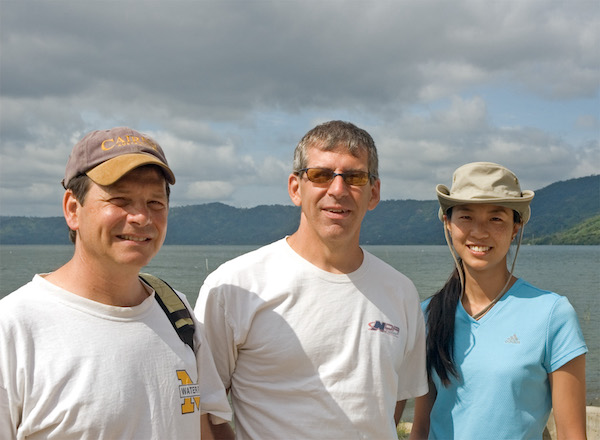
Dr. Ho with Dr. Andy Haig and Dr. Tony Chiodo in Ghana with the University of Michigan
Two years ago, I remember feeling really old when I saw one of the medical students I worked with now volunteering as an examiner. In 2006, I had gone on a trip with Dr. Chiodo and Dr. Andy Haig to Ghana as part of the University of Michigan, and Paras Mehta came with us. He was a fourth-year medical student at that time. I then saw Dr. Mehta when he was serving as an oral examiner that weekend [two years ago]. I felt so old seeing someone I knew as a fourth-year medical student who had already graduated from residency and had been in practice long enough to now be an examiner.

The University of Michigan trip to Ghana in 2007
What keeps you coming back to volunteer?
I want to try and make sure that I continue to contribute to the field as much as I can. By volunteering, you are giving back in your field of expertise and learning from other experts in their subspecialties.
What do you find enjoyable about being an examiner and interacting with the candidates?
One thing I always find is that candidates blow me out of the water with how much they know. It’s amazing to see how much they’ve retained and how much they’ve learned throughout their residency. They know a lot!
What are some lessons you’ve learned in your time as a volunteer?
One lesson I learned as an oral examiner is that you do not want to take the last flight available to get to the Part II Examination. The first time that I volunteered as an oral examiner, I worked a full clinic day and booked an evening flight. I got there, but it was almost midnight. Another lesson is to stay hydrated throughout the weekend as those examination days are long!
To diplomates considering volunteering, what would you say to them?
If you can volunteer, jump at the chance! It’s fun, you learn a lot about the process, it’s a good way to connect with your colleagues, and it is a great way to give back to the field.
What do you do outside of work and volunteering?
I have three kids so I’m constantly running after them. I enjoy gardening, especially since the pandemic. We’re trying to go to the store less which means we are trying to grow more of our own vegetables; we started growing microgreens this winter since our growing season is so short. I also love making sourdough! We bought a grain mill, so now we mill our own grain to do our own sourdough. All I need now are chickens!
Thank you, Dr. Ho, for your work with the ABPMR in the past several years and for your commitment to the examinations as an item writer and examiner. To all the ABPMR volunteers who have dedicated so much of their time and effort to the field of PM&R: thank you!
